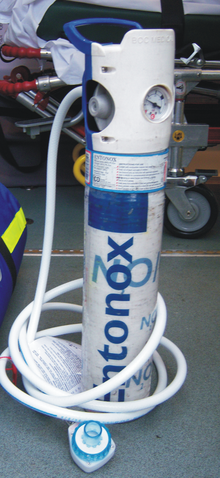 Entonox CD cylinder and giving set | |
| Combination of | |
|---|---|
| Nitrous oxide | analgesic gas (usually 50%) |
| Oxygen | medical gas (usually 50%) |
| Clinical data | |
| Trade names | Entonox, Nitronox, others |
| ATC code | |
| Legal status | |
| Legal status |
|
| Pharmacokinetic data | |
| Metabolism | Not metabolized |
| Metabolites | None |
| Onset of action | 30 seconds[1] |
| Duration of action | 1 minute[1] |
| Excretion | Exhaled |
| Identifiers | |
| CAS Number |
|
| PubChem CID | |
| DrugBank | |
| ChemSpider | |
| UNII |
|
| ChEBI |
|
| ChEMBL |
|
| Chemical and physical data | |
| Formula | N2O |
| Molar mass | 44.013 g·mol−1 |
| 3D model (JSmol) |
|
| |
| |
Nitrous oxide, as medical gas supply, is an inhaled gas used as pain medication, and is typically administered with 50% oxygen mix. It is often used together with other medications for anesthesia.[2] Common uses include during childbirth, following trauma, and as part of end-of-life care.[2] Onset of effect is typically within half a minute, and the effect lasts for about a minute.[1]
Nitrous oxide was discovered between 1772 and 1793 and used for anesthesia in 1844.[3] It is on the World Health Organization's List of Essential Medicines.[4] It often comes as a 50/50 mixture with oxygen.[1] Devices with a demand valve are available for self-administration.[5] The setup and maintenance is relatively expensive for developing countries.[6][7]
There are few side effects, other than vomiting, with short-term use.[1][2] With long-term use anemia or numbness may occur.[2] It should always be given with at least 21% oxygen.[2] It is not recommended in people with a bowel obstruction or pneumothorax.[2] Use in the early part of pregnancy is not recommended.[1] It is possible to continue breastfeeding following use.[8]
- ^ a b c d e f "Anaesthesia UK : Entonox". www.frca.co.uk. 26 January 2009. Archived from the original on 31 October 2007. Retrieved 15 December 2016.
- ^ a b c d e f World Health Organization (2009). Stuart MC, Kouimtzi M, Hill SR (eds.). WHO Model Formulary 2008. World Health Organization. p. 20. hdl:10665/44053. ISBN 9789241547659.
- ^ Myers RL (2007). 100 Most Important Chemical Compounds, The: A Reference Guide: A Reference Guide. ABC-CLIO. p. 198. ISBN 9780313080579. Archived from the original on 2016-12-20.
- ^ World Health Organization (2021). World Health Organization model list of essential medicines: 22nd list (2021). Geneva: World Health Organization. hdl:10665/345533. WHO/MHP/HPS/EML/2021.02.
- ^ British national formulary : BNF 69 (69 ed.). British Medical Association. 2015. p. 878. ISBN 9780857111562.
- ^ Gregory GA, Andropoulos DB (2012). Gregory's Pediatric Anesthesia, With Wiley Desktop Edition. John Wiley & Sons. p. 1148. ISBN 9781444333466. Archived from the original on 2016-12-20.
- ^ WHO model prescribing information : drugs used in anaesthesia. World Health Organization. 1989. hdl:10665/41014. ISBN 92-4-140101-X.
- ^ "Nitrous Oxide use while Breastfeeding". Drugs.com. Archived from the original on 21 December 2016. Retrieved 15 December 2016.